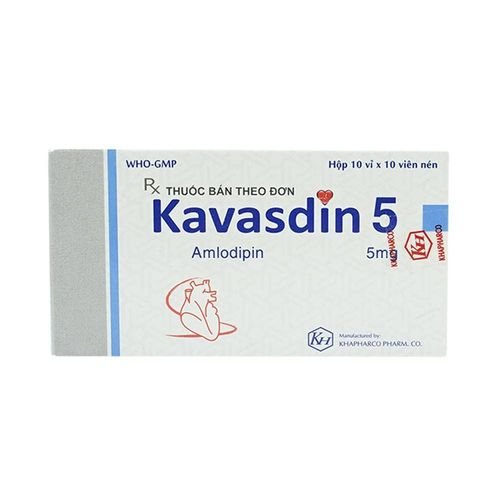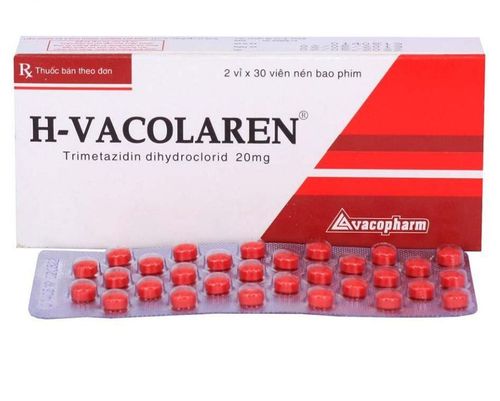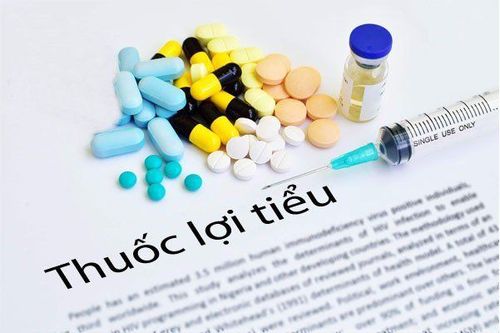This is an automatically translated article.
Kavasdin 5 is a prescription drug, commonly used by doctors in a number of cardiovascular conditions. So what is Kavasdin 5 drug, how to use it?
1. What is Kavasdin 5?
Kavasdin 5 medicine has the main ingredient Amlodipine in the form of Amlodipine besylate 5mg. This is a type of antihypertensive drug, belongs to the group of calcium channel blockers.
Amlodipine is a calcium ion antagonist and inhibits the influx of calcium ions into cardiac and smooth muscle cells. The antihypertensive mechanism of amlodipine is based on its vascular smooth muscle relaxant effect. The exact mechanism by which amlodipine relieves angina is currently not completely determined, but is mainly based on the following two actions:
Amlodipine dilates peripheral arterioles and thereby reduces peripheral resistance to action. affect cardiac contractility (afterload). This offloading effect will help reduce energy consumption and decrease myocardial oxygen demand. Amlodipine also dilates coronary arteries and major coronary arterioles. This helps to increase myocardial oxygen supply in patients with coronary artery spasm. So what disease does Kavasdin 5 treat? The drug is indicated in the following cases:
Hypertension, especially in patients with metabolic complications such as diabetes; Chronic stable angina; Vasospasm angina is also known as Prinzmetal angina. Kavasdin 5 is contraindicated in the following cases:
People who are sensitive to any of its ingredients; Severe hypotension; Shock including cardiogenic shock; Left ventricular outflow tract obstruction such as severe aortic stenosis; Patients with hemodynamically unstable heart failure after acute myocardial infarction.
2. Dosage and how to use Kavasdin 5
For the treatment of hypertension and angina, the dose of Kavasdin 5 should be tailored to the individual patient. So you need to follow your doctor's instructions.
The recommended starting dose of Kavasdin 5 is 5 mg orally once every 24 hours. The dose of Kavasdin 5 may be increased to 10 mg once a day.
If there is no effect after 4 weeks of treatment, the dose of Kavasdin 5 can be increased. There is no need to adjust the dose of Kavasdin 5 when combining Thiazide diuretics. Overdosage of Kavasdin 5 may cause excessive peripheral vasodilation, leading to marked and possibly prolonged systemic hypotension. At this time, the patient should be treated with aggressive cardiovascular supportive measures including regular cardiac and respiratory function checks, extremity elevation, and monitoring of circulating fluid volume and urine output.
If the patient has no contraindications to vasopressors, it can be used to help restore blood pressure. Intravenous administration of calcium gluconate may reverse the calcium channel blocker effect. Gastric lavage may be helpful in some cases. Because amlodipine is highly protein bound, dialysis is unlikely in this case.
3. Side effects of Kavasdin 5 The most common side effect of Kavasdin 5 is ankle edema, which is mild to moderate, related to the dose. In a placebo-controlled clinical trial, this adverse event occurred in approximately 3% of patients treated with 5 mg/day and about 11% with 10 mg/day.
Common side effects of Kavasdin 5 include:
Ankle edema; Headache; Dizzy ; flushing and feeling hot; Tired; Attenuate; Palpitations ; Cramp; Nausea, abdominal pain, indigestion; Shortness of breath. Less common side effects of Kavasdin 5 include:
Excessive lowering of blood pressure; Fast heart beat; Chest pain ; rash, pruritus; Muscle pain, joint pain; Sleep disorders. Rare side effects of Kavasdin 5 include:
Extrasystoles; Increased profit margin; Urticaria; Increased liver enzymes; Increased blood glucose; Confusion; Various erythema. During the use of Kavasdin 5, if you experience any side effects of the drug, you should immediately notify your doctor for appropriate treatment.
4. Drug Interactions Kavasdin 5 with Other Drugs Anesthetics increase the blood pressure lowering effect of Kavasdin 5 and may cause a more drastic drop in blood pressure; When using Kavasdin 5 with lithium, it can cause neurotoxicity, nausea, vomiting, diarrhea; Nonsteroidal anti-inflammatory drugs, especially Indomethacin, may reduce the antihypertensive effect of Kavasdin 5 by inhibiting prostaglandin synthesis and/or sodium and fluid retention; Drugs that are highly protein bound (such as coumarin derivatives, hydantoin...) need to be used with caution with Kavasdin 5, because amlodipine is also highly protein bound, so the concentrations of these drugs are in the free form in the blood. Blood may change.
Please dial HOTLINE for more information or register for an appointment HERE. Download MyVinmec app to make appointments faster and to manage your bookings easily.













